Giardiniera is the perfect relish of pickled vegetables. It’s the ultimate homemade condiment — ready in only 24 hours, but staying fresh for weeks.

What is Giardiniera?
Giardiniera is an Italian pickle relish packed full of bright and colorful veggies. The usual suspects in this pickled vegetable recipe are carrots, cauliflower, and peppers — however, other veggies are often used as well. After the vegetables are pickled, they have a vinegary and herby flavor.
Giardiniera originates in Italy, although like many international recipes, there are cultural and geographical variations. One popular version is the Chicago style giardiniera. This relish differs from Italian-style as it rarely contains vinegar. Instead, it’s made primarily with olive oil and herbs.
This pickled vegetables recipe leans closer to the Italian style, but also contains elements of our own family history, as it’s been in my family for over 15 years. It’s so good — we have it at almost every single family party.
How To Make Giardiniera
Pickling doesn’t have to be hard. This quick pickling recipe makes it easy. Follow the instructions below to get crisp and crunchy veggies each and every time.
- Prep the vegetables: Gather and clean all the veggies.
- Dice and mix the veggies: Dice all the veggies into similar sized pieces, then mix them together in a large bowl.
- Make the pickling brine: Combine all the liquids and spices in a pot. Bring to a boil, then pour the hot white vinegar brine over the vegetables.
- Soak the veggies: Allow the veggies to soak in the brine for at least 24 hours at room temperature. After a day has passed, place veggies and brine into mason jars or airtight containers.
- Store: Store in the refrigerator for up to two weeks.




What Vegetables Can Be Pickled?
This pickled veggies recipe is super versatile and allows you to get creative. Find a couple vegetable substitutes below and mix and match them as you please. For the most colorful giardiniera, choose a veggie from each color subgroup.
- Green: Asparagus, zucchini, celery, green beans, okra, artichoke hearts, cucumbers
- Brown: Crimini mushrooms
- Red/Purple: Turnip, red onion, tomatoes, radishes, beets, eggplant
- Yellow: Squash
- White: Onion, garlic
Hot tip: This tip is literally hot. If you like things spicy, add in red pepper flakes and jalapeños. Adjust as you see fit.

Tips from the Kitchen
For the best flavor and texture, as well as a way to keep track of how old your pickled vegetables are, follow these tips.
- Use fresh vegetables: The best pickled vegetables come from high quality, fresh veggies. We love buying veggies from the local farmer’s market, but a great alternative is to buy the best looking veggies at the grocery store.
- Taste the brine: Taste the brine to see if it suits your flavor preferences. If it’s too sweet, add more vinegar. Too strong? Add more water. For even more flavor, add mustard seeds, dill, or more bay leaves and black peppercorns.
- Label the jars: Label your jars with the date you make the pickles to keep track of how long they’re in the fridge.
- Pour the brine while it’s hot: Using a hot brine allows for the flavors to meld better together, as well as speed up the pickling process.

How Do I Serve Giardiniera?
This relish pairs perfectly with rich and savory dishes like steak sandwiches to burgers and roasted shredded beef. If you’re a fan of charcuterie boards or antipasto platters, this relish is a great addition in a small bowl of its own. Or, giardiniera is also the perfect ingredient to level-up salads. Toss it straight into a classic garden salad for a taste of tang. The vinegar brine from the pickled vegetables is great to use as a dressing for the salad.
Storing Giardiniera
The best part about giardiniera is that it’s quick to whip up and lasts so long when stored or preserved properly. To last for up to two weeks, refrigerate the giardiniera in a mason jar with the lid screwed tight. Ensure the veggies are always submerged in the pickling liquid to keep them fresh. It’s always great to have a jar stowed away in the back of the fridge for last minute guests and get-togethers.
FAQ
Are pickled vegetables healthy?
Pickled vegetables are full of the same vitamins and nutrients that fresh vegetables have. However, due to the nature of the brine, the liquid can have high amounts of sugar and salt.
What’s the difference between quick pickling and canning?
Quick pickling is a fast process of using a brine to pickle a veggie for usually a short period of time (up to a couple weeks). On the other hand, canning traditionally uses boiling water to create the brine and to vacuum seal a jar for longer storage.
Do pickled veggies lose nutrients?
Pickling does not cause vegetables to lose nutrients. In many cases, pickling is thought to introduce good probiotics that aid in digestion.
More Pickled Veggies
- Pickled Mushrooms —These go great with any beef straight off the grill
- Curtido — Salvadoran cabbage slaw
- Quick Pickled Beets — Use them for salad or soup
- Pickled Jalapenos — From tacos to pizza, there’s never a bad occasion for pickled jalapeños
- Pickled Onions — Pop them on a steak sandwich or on carne asada tacos
- Quick Pickled Asparagus — Add this tasty asparagus to your charcuterie boards or simply enjoy as a snack
Recipe
Ingredients
- 1 Small Cabbage
- 1 Large Red Bell Pepper
- 1 Large Yellow Bell Pepper
- 1/2 Medium Cauliflower
- 1 Small Broccoli
- 1 Large Carrot
- 1 Medium Yellow Onion
- 5 cup Water
- 1 cup Light Olive Oil
- 1 1/4 cup White Vinegar
- 1 cup White Sugar
- 3 tbsp Salt
- 5 Bay Leaves
- 20 Peppercorns
Instructions
- Gather and clean all your veggies for pickling.
- Dice all the vegetables into same-sized pieces. I like to stick to around one-inch in size. Mix vegetables together in a large dish. Preferably something that you can cover with a lid for marinating.
- Into a small saucepan, combine together water, oil, vinegar, sugar, salt, bay leaves, and peppercorns. Bring the sauce to a boil and pour the sauce over the prepared vegetables.
- Let the vegetables marinade for at least 24 hours. After 24 hours, you can place them in mason jars or other airtight containers.
- When stored properly, the relish will last for up to two weeks.
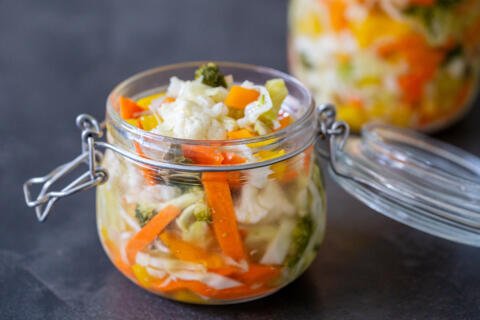
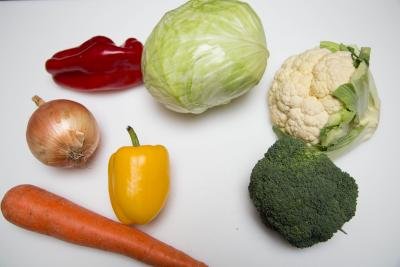
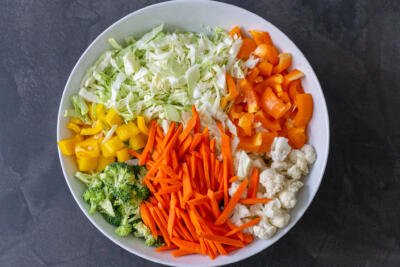

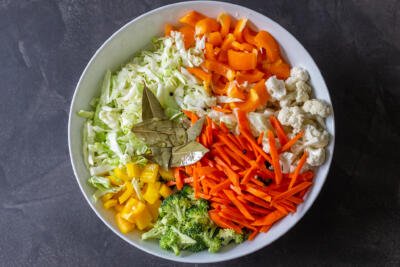

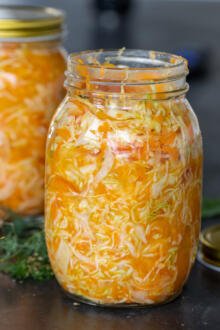
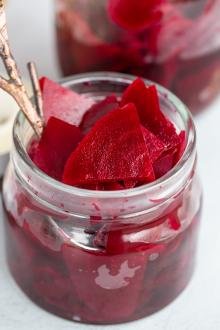
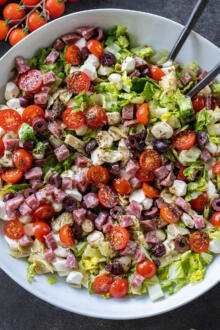
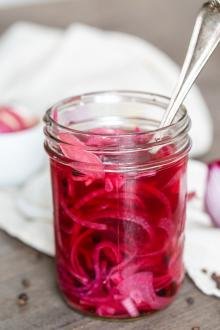

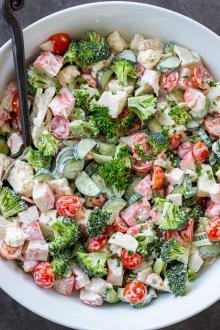
For couple of years now I make this salad for Holidays and different events and everyone loves it. My niece can eat a bucket and then ask for more (she's 5).
Absolute favorite.
Lily, Your niece has to be my favorite 5-year-old!!! I absolutely loved your comment—it truly made my day!
Are the veggies supposed to be submerged in the marinade?
Hi Lily, Not right away — they don’t need to be fully submerged at first. You can give everything a stir, and the veggies will shrink down a bit as they sit. Enjoy!
Can I use apple cider vinegar instead of the regular white vinegar? What’s the difference between using the hot marinade vs chilled one?
Hi Anna, the flavor of the veggies will change if you use apple cider vinegar. I prefer the flavor of white vinegar. Also, the hot marinade cooks veggies slightly so they marinade better. Hope this helps!
Thank you for sharing this recipe. I’ve been making this salad quite often . Perfect for hosting or prepping ahead of time. Be blessed
Thank you Inna. I love that's it's great for making ahead!
I have gone pickle craze - plant my own vegetables - plenty of carrots spinach cauliflower cabbages beetroots beans & onions
Ideal recipe to combine all together
Hi Ric, It's so awesome to have home grown veggies to pickle. Enjoy!
Do you need to sweat the eggplant if you plan to use that instead of one of the other vegetables?
Hi Hayley, no, you wouldn't need to sweat eggplant. You can cut it up and follow interactions as the rest of the ingredients.
Can I use monk fruit as a sugar replacement?
Hi Ivonne- I can't say because I haven't tried using monk fruit as a substitute. If you give it a try, please let us know how it went for you!
When you say yo let it marinate for 24 hours, is that in the refrigerator? I am assuming so but just making sure. Also, do you have to use 1cup sugar?
Hi Erica - Yes! You let it marinate in the fridge for 24 hours. For the sugar, that's always what we've used, so I'm not sure about the taste if you lessen it. If you try it with less sugar, do let me know how it turns out!
We do a lots of cold pack bottling in which we bottle and put a seal lid on and submerge in boiling water for 30 min.
Would this recipe work for that? Or would the veggies get to soft?
Hey Reagan, I am not sure if it would work. I have never tried that method. Let me know if you try it.
What dressing would you put on a garden salad that had marinated vegetables in it?
Hey Mary, you can use this one or use a combo of olive oil and lemon juice.
Can I use sunflower and extra virgin oil instead?
Hey Alena, you definitely can. Enjoy
I am excited to do this will all the veggies!! It adds such great flavor!
Agreed, it's such a simple and delicious recipe!
What a great recipe!! I have learned to love pickled veggies. They taste great with so many things! Happy they last a while in the fridge!
Yes these veggies are great to just pull out and enjoy with any meal!
Looks delicious! Can't wait to try this.
I hope you love the recipe!
Do you pour hot marinade over vegetables or you cool it down fist? And also do you strain it once it is ready to eat?
Use hot marinade. Yes do strain it and refrigerate it. You may still have some juice in it, that’s fine.
Thanks for responding and thanks for sharing all the recipes!!!
No problem! Enjoy Holidays!
Just finished the recipe. So excited to try the salad; it one of my favorites at events! Thank you for sharing the recipe. 🙂
Hey Alina, I totally agree with you about this salad, perfect one for events. You get everything done several days ahead and that's what makes it easy. Thanks for saying hi 😉
Can I use vegtable oil instead of light virgin oil? Is it going to make taste difference?
I just finished putting this together. Two things.
1 the "small saucepan" you boil in better be 3 quarts or larger.
2 it doesn't indicate what you do with this the first 24 hours. I am guessing it sits on the counter covered.
I will add that note about pan size. It would sit in a room temperature for the first 24 hrs. After that you would need to keep it refrigerated.
Oh u don't know how much we loved that salad!!! I made it few times already and it was delisious!!! I skip a few ingredients cause I didn't have them but my hubby even drink some marinade!!!:) thank you so much for sharing and God bless!!!
Oh my goodness, you made my day! He drinks the marinade, that's pretty funny! We use to drink marinade form pickled tomatoes, have never tried this marinade.
I think this is something we would like 🙂 thank you Natasha for sharing these great recipes with us. What percent of vinegar should I use for this salad?
It is 5% vinegar. Thank you for your nice words;) I absolutely love sharing all the recipes 😉